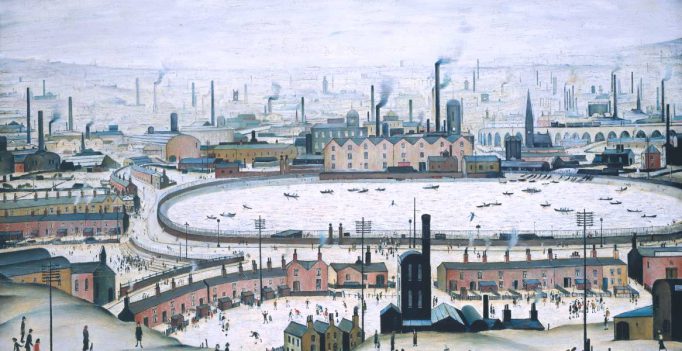26th June 2013 – 20th October 2013, Tate Britain, 16.50GBP – Concession 14.50GBP
Summary
Laurence Stephen Lowry (1887 – 1976). During his lifetime and after would become a cornerstone of Britishness and a key contributor to urban industrial art. Able to see the beauty in things all around him that others would miss made his body of work haunting and often resonates with a coarse grittiness in whose friction gives such reward to the eye.
Subject matter
The withheld joy and faded derivations of everyday life come to mind when appreciating Lowry’s work. He was a painter who not merely painted factories, terrace houses and working class rituals but loved to do so. In Lowry there is a great sense of movement surfaced particularly well in, Fun at the Fair, Daisy Nook 1953. The tableau thronging with people creates inviting arrangements mothers pushing prams, children waving sparklers, couples in mid conversation and vendors going about their business. The mid-ground punctuated by dense crowds with the ground barely visible under foot leads the eye to the focal point where tents and temporary structures are erected past which the rolling fields in the background reveal the sky and in the distance one can make out a faint factory building.
Colour and connotations
There is a grubby stagnant quality to Lowry’s palette. Whether this was used to heighten perceptions of working class immobility is hard to tell? It suggests a sombre existence. Pallid faces whose features are described with little affection clad in uniformity. Yet from these downcast sullen despairing scenes the fabric and sinews of life jump out where one ably traverses the picture plane into that other world for something like an eternal moment. Say the word Lowry and you invoke a cultural imaginary of little match-stick men though not all Lowry’s figures were treated in this way, Head of a Man with Red Eyes 1938, The Funeral Party 1953 and Ancoats Hospital Outpatients’ Hall 1952 demonstrate attentive treatments whilst allowing one to get closer to Lowry’s subjects.
About the man
Lowry was slightly introverted and eccentric. His oddities included a collection of clocks all set to different times and keeping a briefcase by his door in case of unwanted visitors. He worked as a rent collector for the Pall Mall company and reached the position of chief cashier. Something which he tried to hide wishing to appear as a serious and not a Sunday painter. He studied at the Manchester School of Arts (1905) under Adolphe Valette an impressionist and went onto the Salford Royal College (1915). Lowry was not survived by any children he never married – but as if by fate his estate was left to Carol Ann Lowry. In 1957, a girl bearing the same family name of no relation wrote to Lowry asking for advice on becoming an artist who was close to Lowry throughout his life.
Lowry, style and realism
Lowry’s style is undignified without grandeur almost forlorn. To what end? As a metaphorical cliche, to convey an emotive verisimilitude or even just to be? Lowry is his style like a filter applied to a camera lens the reality transmogrifies via Lowry attaining an authenticity more real and of greater substance than any photo or sequence of moving images could achieve. Lowry painted from a mixture of memory and real life and Lowry’s phantasmagoria was not concerned with injustice or bitterness, did not want to commentate on inequality perhaps he simply tried to get at near to the truth. Van Gogh knew this truth when he painted A Pair of Shoes 1885 and like Van Gogh, Lowry was interested and captivated by a sense of the thing rather than the thing itself.
OUTLINE
A truly iconic (retrospective) exhibition of a British artist who painted the very fabric of industrial life and rituals of Northern working class Britons.
written by: Colin Humphrey
